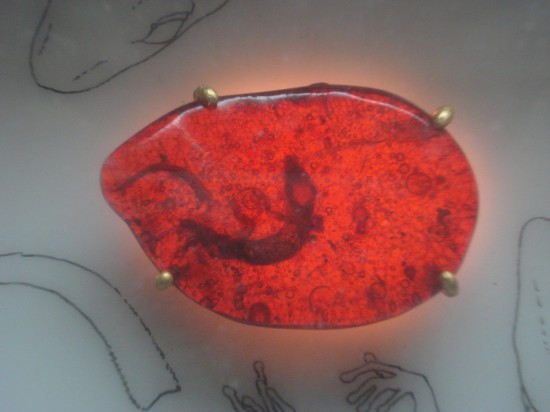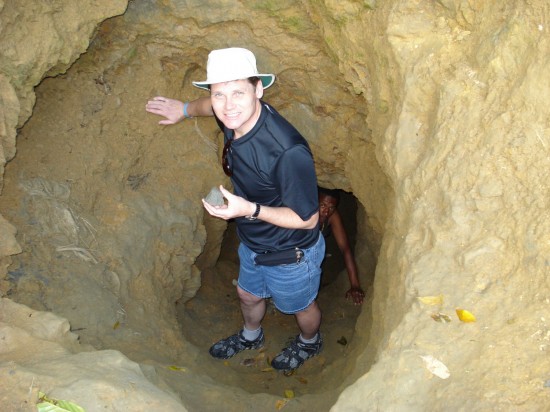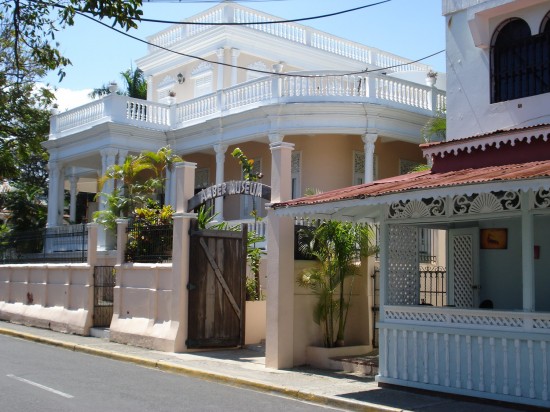The rickety taxi bumped and rattled its way southward, into the scenic peaks of the Dominican Republic’s northern cordillera. Frequent washouts from seasonal torrential rains made the going tricky and, at times, even a little perilous. However, we finally arrived at a small community, the site of bountiful mines producing high quality Dominican amber. With me was Orlando Yaemar, the manager of the Amber Gallery in Puerto Plata, who had kindly arranged to take me to one source of his museum’s varied displays. Along the way, he explained the history of amber, especially that of the deposits found on his native island of Hispaniola (composed of the Dominican Republic in the east and Haiti in the west).
Dominican amber differs greatly from the world’s other major source of amber, around the Baltic Sea. In the Dominican Republic, the gem is composed of the fossilised resin of Hymenaea protera, an extinct tree of the family Leguminoseae. Dominican amber, unlike Baltic, is not composed of succinite, but rather is retinite. The amber here is much clearer and also is ten times more likely to enclose identifiable inclusions, such as insects or plants. Baltic amber, in its natural form, is less aesthetically pleasing and, when sold as jewellery, almost always has to be treated by boiling in oil to clarify the amber and fill in the air bubbles, which make the fossilised resin opaque. Dominican amber does not require these treatments.
The deposits have been known in Europe since 1493, when a Taino Indian gave Christopher Columbus a gift of the gem. Despite this long history, the country’s amber has only recently become widely known, perhaps because of its relative rarity. There are three mining areas currently being exploited on the island of Hispaniola, the other two being found in the east at Sabana and Bayaguana.
It is said that Michael Crichton got the idea for parts of his book Jurassic Park at an amber museum in Puerto Plata. However, since most Dominican amber dates from the lower early Miocene epoch, it is generally 20 to 25 million years old, though some deposits may date from as much as 40 to 45 million years ago. While you might clone some interesting creatures from blood found in a fossilised Dominican mosquito, it is unlikely that you would get a dinosaur! These were extinct at the end of the Cretaceous period, at least 20 million years before the oldest of the Dominican amber was formed. However, those who wish to see velociraptors running around their back yard can take heart in the fact that, in some parts of the world, amber can date back 345 million years, well before the first dinosaur trod the earth’s surface.
Amber forms when heat and pressure causes young, buried tree resin (called copal) to polymerize. It can take on various pigments. The colours that Dominican amber can assume are extremely varied, ranging from yellow, orange, brown and gold, to black, red, silver, white and even a rare and highly prized blue. Blue amber has qualities comparable to those of the deep blue Dominican sky and the turquoise waters that lap at the island’s beaches. Neither the amber, nor of course the sky or the water actually contains blue pigment and any azure colouration is purely due to the way the medium refracts light. In the case of blue amber, this effect is felt possible to be due to certain hydrocarbons contained within the resin from exposure to volcanic activity.
By now, armed with a wealth of information imparted by Orlando, we arrived at our destination and met two of the miners, who work the sandstone strata of the northern cordillera. Both were named Jose. Following our guides, we trudged down rutted jungle paths to the entrances of several mines.
Far from being high tech, mechanized operations, the Dominican amber mines are laboriously dug by hand tools, often with only candles or lanterns supplying light. Mechanized operations would damage or destroy the delicate amber.
Working these mines can be hazardous but the reward great, especially for a prime piece of blue amber or for the discovery of a very rare inclusion, such as a lizard. I followed one of our guides through a mine entrance into a narrow tunnel on my hands and knees. By the light of a dim flashlight, I watched as he used a hammer and chisel to hack out a piece of sandstone studded with an angular chunk of the prized resin. Seeing the labour involved gave me a new appreciation for the people who mine the gem.
Scuffed and dirty, we departed the mines and made our way to the home of Juan, an intermediary who purchases the amber from the miners and sells it to those who polish, cut and set it for the market. I looked at a variety of pieces of raw amber and purchased two, which showed some bluish coloration. As we were leaving, Juan made me a gift of a piece of sandstone we had just extracted, amber still in situ, to add to my collection.
Next stop was Puerto Plata and the Amber Gallery. Centrally located on Calle 12 de Julio, the gallery has an impressive museum containing displays of unique specimens of amber, including many with rare inclusions. These can run the gamut from plants and flowers, scorpions, lizards, feathers and insects, such as wasps, bees, flies, beetles and ants. Amber can also be carved easily, due its softness (around 3 on the Moh scale). The museum also has several displays of artefacts of the Taino Indians, Hispaniola’s extinct native people.
Gallery guide, Patrick Damus, demonstrated how to identify real amber from fake using only salt water, explaining that real amber floats but simulations sink. He then presented me with four similar looking pieces, two fake and two real, and asked me to ascertain which was which. After carefully eying the four ‘gems’, I selected the two pieces I felt confident were real. Placed in salt water, both my selections promptly sank!
Patrick further explained that real amber will also take on an electric charge when rubbed with silk and, in ancient Greece, was called elektron, hence the origin of the word ‘electricity.’ Another test is to apply a heated needle. Real amber will give a resinous scent but a fake will emit a sharp, acrid odour. (However, this is not recommended as it will damage the amber.)
After leaving the museum, I made my way to the Amber Gallery’s shop. This contains a large variety of amber jewellery as well as examples of the Dominican Republic’s other unique gem, larimar, a rare form of blue pigmented pectolite. This is found only on Hispaniola. While the beachside shops and markets abound with ‘amber’ jewellery, much of it is either fake or, if genuine, is composed of pressed amber resin or is treated Baltic amber. Inclusions can also be easily faked and obviously fabricated pieces were very common six years ago when I visited Punta Cana, at the eastern end of the Dominican Republic. Government regulations seem to have subdued this practice somewhat, though it is still caveat emptor. Dealing with a reputable shop is recommended, if you are searching for quality specimens.
As I exited the gallery, I thanked Orlando for all his help in researching the Dominican amber industry. He smiled and presented me with a small package. Opening it, I saw that he’d had his gem cutter polish the two pieces I’d purchased at the mine. One now glowed a rich honey colour, the other a luminous electric blue, arguably the most beautiful fossils I will ever add to my collection.
For further information contact:
The Amber Gallery
Calle 12 de Julio Esq. Jose del Carmen Ariza
Puerto Plata, Dominican Republic
Tel 809-586-6467
Fax 809-586-6025
Photo Credits
All Photos By George Burden – All Rights Reserved







Hello!!! I just read your article on Dominican Amber. I have been living in the DR for almost 8 years now, I am a real estate broker, originally from Montreal. I have recently been approached by a Dominican to enter the Amber business, I think blue amber is absolutely beautiful.
I have clients that are interested; but I am at a bit of a loss to evaluate the land, You wouldn’t happen to have any suggestions as to how to determine if there is amber on the land? I appreciate your tie, have a great day!!